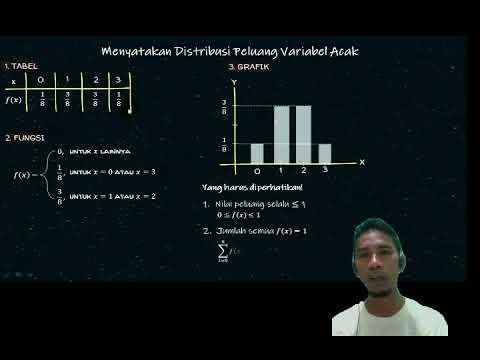Distribusi Peluang Variabel Acak Diskrit Part 1
Summary
TLDRThe video tutorial focuses on random variables and probability distributions. It begins by explaining the concept of random variables, denoting their probabilities, and establishing the requirements for a valid probability function. Through examples like dice and coin tosses, it illustrates how to construct probability tables and graphical representations of distributions. The tutorial emphasizes the importance of understanding the total probability summing to one and provides various techniques, including Pascal's Triangle, to simplify calculations for multiple trials. The content is practical, guiding viewers through determining probabilities for different scenarios effectively.
Takeaways
- 🎲 Random variables have their own probabilities, denoted as FX, which expresses the likelihood of a random variable taking a specific value.
- 📊 Probability distributions can be presented in three forms: tables, graphs, and functions.
- ⚖️ A probability function must satisfy two conditions: probabilities must be between 0 and 1, and the sum of all probabilities must equal 1.
- 🎲 When rolling a single die, the probabilities for each outcome (1 through 6) are all equal, each being 1/6.
- 💰 For tossing two coins, the probabilities of getting 0, 1, or 2 heads can be determined based on possible outcomes.
- 🧮 Using Pascal's triangle simplifies calculating probabilities for multiple coin tosses, where each row represents possible outcomes.
- 🎲 For rolling two dice, the sum of the faces shows a range of possible outcomes (2 to 12), with varying probabilities for each sum.
- ⚙️ The likelihood of specific sums when rolling two dice can be calculated by counting favorable outcomes over total outcomes.
- 🔢 In probability distributions, if a function assigns values to probabilities, ensure they adhere to the required mathematical conditions.
- 🔍 When given partial information about probabilities, algebraic methods can be used to find unknown values while maintaining the total probability of 1.
Q & A
What is a random variable as mentioned in the transcript?
-A random variable is a variable that takes on numerical values, each associated with a specific probability. It is used to quantify the outcomes of a random phenomenon.
How is the probability of a random variable typically denoted?
-The probability of a random variable is usually denoted as FX, where FX represents the probability that the random variable X takes on a specific value.
What are the two main conditions that a probability function must satisfy?
-1) The probability must be between 0 and 1 (inclusive), and 2) The sum of the probabilities of all possible values of the random variable must equal 1.
What is the probability distribution of a random variable?
-The probability distribution of a random variable describes how the probabilities are distributed over the values of the random variable. It can be presented in the form of a table, graph, or probability function.
In the example of rolling a die, what are the possible values for the random variable X?
-In the case of rolling a single die, the possible values for the random variable X are 1, 2, 3, 4, 5, and 6.
What is the probability of rolling a specific number on a fair six-sided die?
-The probability of rolling any specific number on a fair six-sided die is 1/6, since there is one favorable outcome out of six possible outcomes.
How does the transcript illustrate the concept of flipping two coins?
-The transcript describes flipping two coins as a random variable where X represents the number of heads. It presents possible outcomes and calculates the probabilities for 0, 1, and 2 heads.
What role does Pascal's Triangle play in probability calculations as mentioned in the script?
-Pascal's Triangle is used to easily calculate combinations, which helps determine probabilities for events involving multiple coin flips or other similar random experiments.
How are the probabilities for the sum of two dice calculated?
-Probabilities for the sum of two dice are calculated by determining the number of ways each sum can occur and dividing by the total number of possible outcomes (36 for two dice).
What steps does the transcript suggest for determining the value of k in a probability distribution?
-To determine the value of k, the transcript suggests ensuring the total probability sums to 1. This is done by setting up an equation with the known probabilities and solving for k.
Outlines

Этот раздел доступен только подписчикам платных тарифов. Пожалуйста, перейдите на платный тариф для доступа.
Перейти на платный тарифMindmap

Этот раздел доступен только подписчикам платных тарифов. Пожалуйста, перейдите на платный тариф для доступа.
Перейти на платный тарифKeywords

Этот раздел доступен только подписчикам платных тарифов. Пожалуйста, перейдите на платный тариф для доступа.
Перейти на платный тарифHighlights

Этот раздел доступен только подписчикам платных тарифов. Пожалуйста, перейдите на платный тариф для доступа.
Перейти на платный тарифTranscripts

Этот раздел доступен только подписчикам платных тарифов. Пожалуйста, перейдите на платный тариф для доступа.
Перейти на платный тарифПосмотреть больше похожих видео
5.0 / 5 (0 votes)






